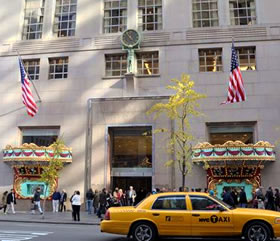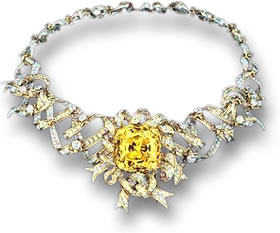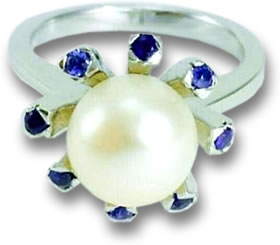|
|
Your Details
|
|
Your Details
|
Reviewed By Andreas Zabczyk
Tiffany & Company Tiffany & Company in New York City
Tiffany & Co is an American jewelry retailer that is known all over the world. The New York City company was founded by Charles Lewis Tiffany and John B. Young in 1837. The story of Charles Lewis Tiffany embodies the American dream. On the first day of business, the takings of Tiffany and Young's "stationery and fancy goods store" amounted to a mere $4.98. However, this soon changed. The Tiffany DiamondsIn the 1840s, Charles Lewis Tiffany took the calculated risk of buying diamonds from Europe. After the French revolution and abdication of Louis Philippe, members of the French aristocracy sold their treasured jewels in order to raise funds to relocate and avoid the political turmoil in France. Tiffany's acquisition of such exceptional diamonds earned him the nickname, "King of Diamonds". Thus began the association of Tiffany with diamonds. Tiffany & Co. is now known for the "Tiffany Diamond", which is a fancy yellow diamond. The Tiffany Diamond was discovered in 1877 in the South African Kimberley Mines. The rough stone weighed 287.42 carats. A year later, Tiffany bought the stone and had it cut down to 128.54 carats; the cutting was supervised by George Frederick Kunz, the resident gem expert at Tiffany's. The famous stone was later set into a Ribbon Rosette necklace designed by Jean Schlumberger and worn by Audrey Hepburn in publicity photos for the iconic movie, "Breakfast at Tiffany's" (see image, below). Hepburn was the second woman to have worn the famous gemstone.  The Tiffany Diamond in the Ribbon Rosette Necklace
In 1995, Jean Schlumberger's "Bird on a Rock" brooch was mounted. This brooch was displayed at Tiffany & Co. and in the Smithsonian Museum of Natural History in New York in 2006. In 2012, the Tiffany Diamond was set into a white diamond and platinum necklace and exhibited around the world to celebrate Tiffany's 175th anniversary. It now resides in the Fifth Avenue Tiffany & Co. store in New York. The Tiffany Diamond is said to be one of the largest and finest yellow diamonds in the world. Blue Book & Tiffany BluePart of the Tiffany & Co. brand is a certain shade of robin's egg blue, known as "Tiffany Blue". This is the color of fine turquoise, which is the gemstone thought to have inspired the signature color choice. Tiffany Blue was first seen on the cover of the Blue Book, which was the first mail-order catalogue published in the US. The Blue Book of 1845 was sent to customers as part of the Tiffany service. The Tiffany Blue Book is now considered to be a work of art in itself, with glossy color pictures of beautiful jewelry. Some editions are highly sought-after and valuable. The Blue Book is sent out only to certain customers, depending on purchases, and displays the most sumptuous gems and jewelry. Tiffany Blue is also the color used for the boxes in which Tiffany products are presented, tied with a white ribbon. Colored GemstonesTiffany & Co. began with only "precious" gemstones; emerald, ruby, diamond and sapphire. Later, the company was responsible for acquainting the world market with some colored gemstones that may have remained relatively unknown otherwise. Such gems include tourmaline, which was sold to Charles Comfort Tiffany by George Frederick Kunz in 1875. Another gem type that was popularized by Tiffany & Co. is tanzanite. After its discovery, tanzanite was rejected by the Saks Department Store jewelry department, but admired by Tiffany & Co. who gave it the name "tanzanite", after the location of its discovery in the hills of Northern Tanzania. On the Tanzanian and Kenyan border, a green variety of garnet was found by Campbell Bridges and named tsavorite, after the Tsavo National Park, by Henry B Platt, who was the president of Tiffany at the time. Mr Bridges and Tiffany & Co. introduced tsavorite garnet to the world. Another colored gem that was marketed by Tiffany & Co. is kunzite, which was first discovered in the USA, and then named after George Kunz, the first man to describe the pink-violet variety of spodumene. The more delicate pink gemstone, morganite, was named after esteemed Tiffany & Co customer and gemstone collector, J.P. Morgan.  Silver, Pearl and Sapphire Ring
World Class Silver JewelryTiffany & Co. has long been famous for silverware, especially the iconic Tiffany heart tag bracelet and necklace. The company has been selling silverware since 1837. Shortly after Tiffany & Co. became known for diamonds, the company implemented the 925/1000 silver standard, leading the US silver industry. This means that the silver is comprised of 925 parts per 1000 parts silver. It consists of 92.5% silver and 7.5% other metals, typically copper. This was the British sterling silver standard and was adopted by Tiffany and then the whole of the US. Tiffany's silverware won a number of international awards, including the prestigious Grand Prize for Excellence at the 1878 Exposition Universelle in Paris for a stunning "Japanesque" silver and mixed metals piece. All of the above has contributed to Tiffany & Company's popularity and iconic status over the years. If you ever find yourself wandering down Fifth Avenue, New York City, be sure to pay a visit to Tiffany & Co., whether it is to see their beautiful gems and jewelry, or simply to stare at the creative window displays, which draw people from all over the globe. |
